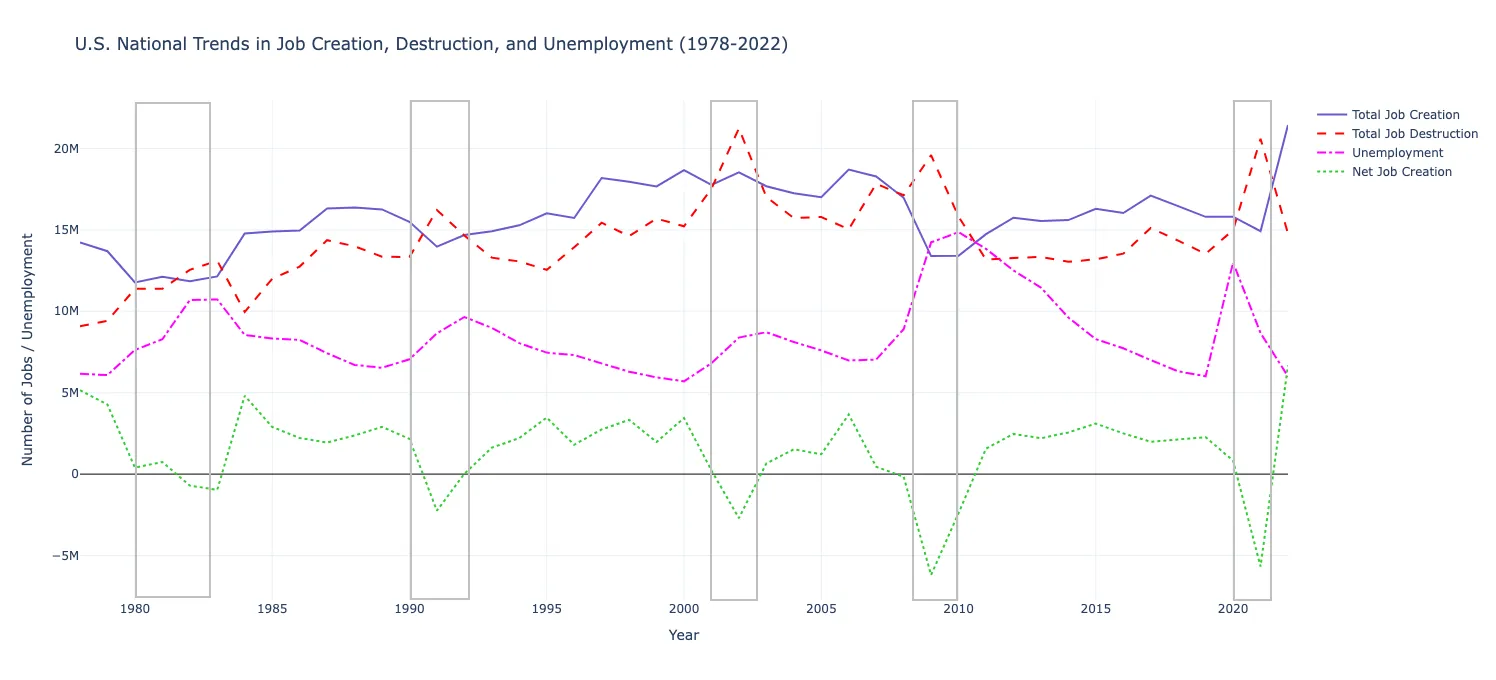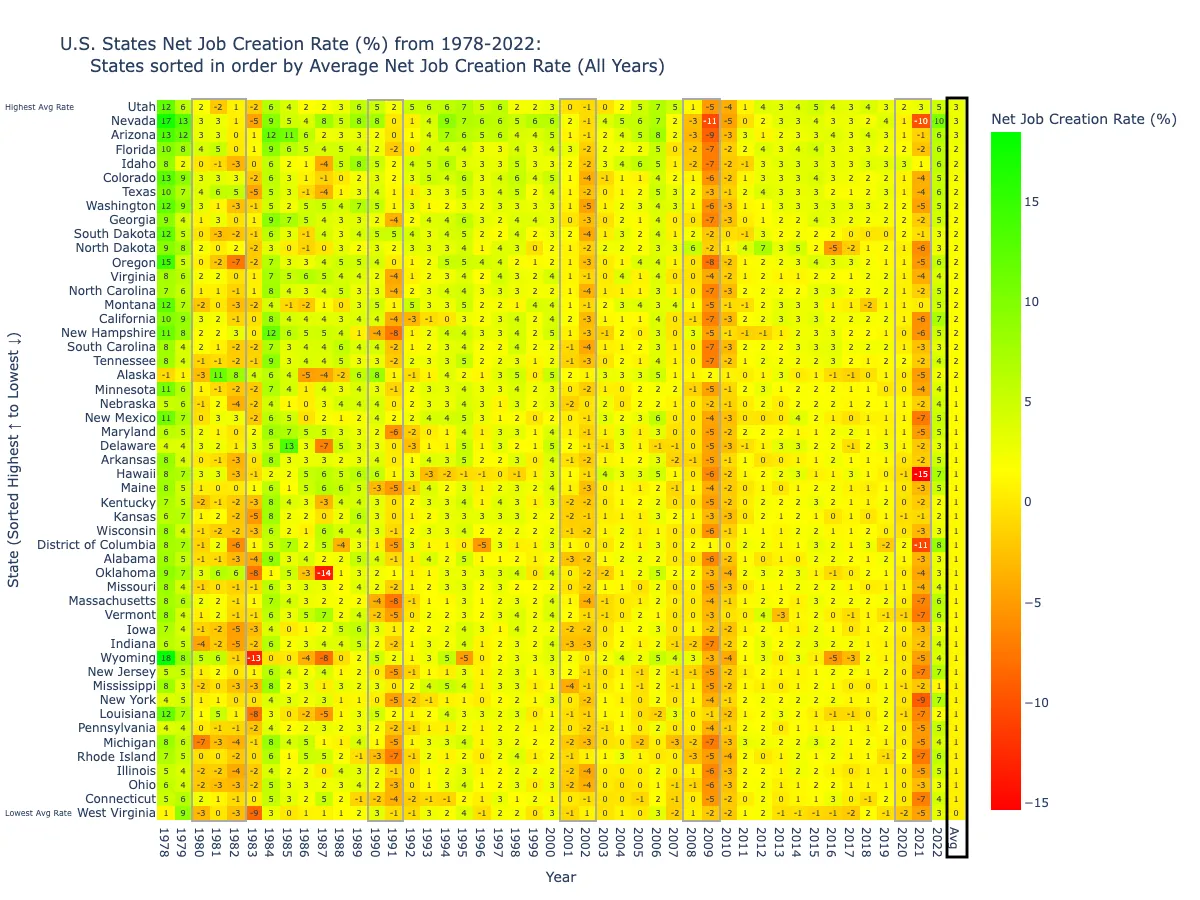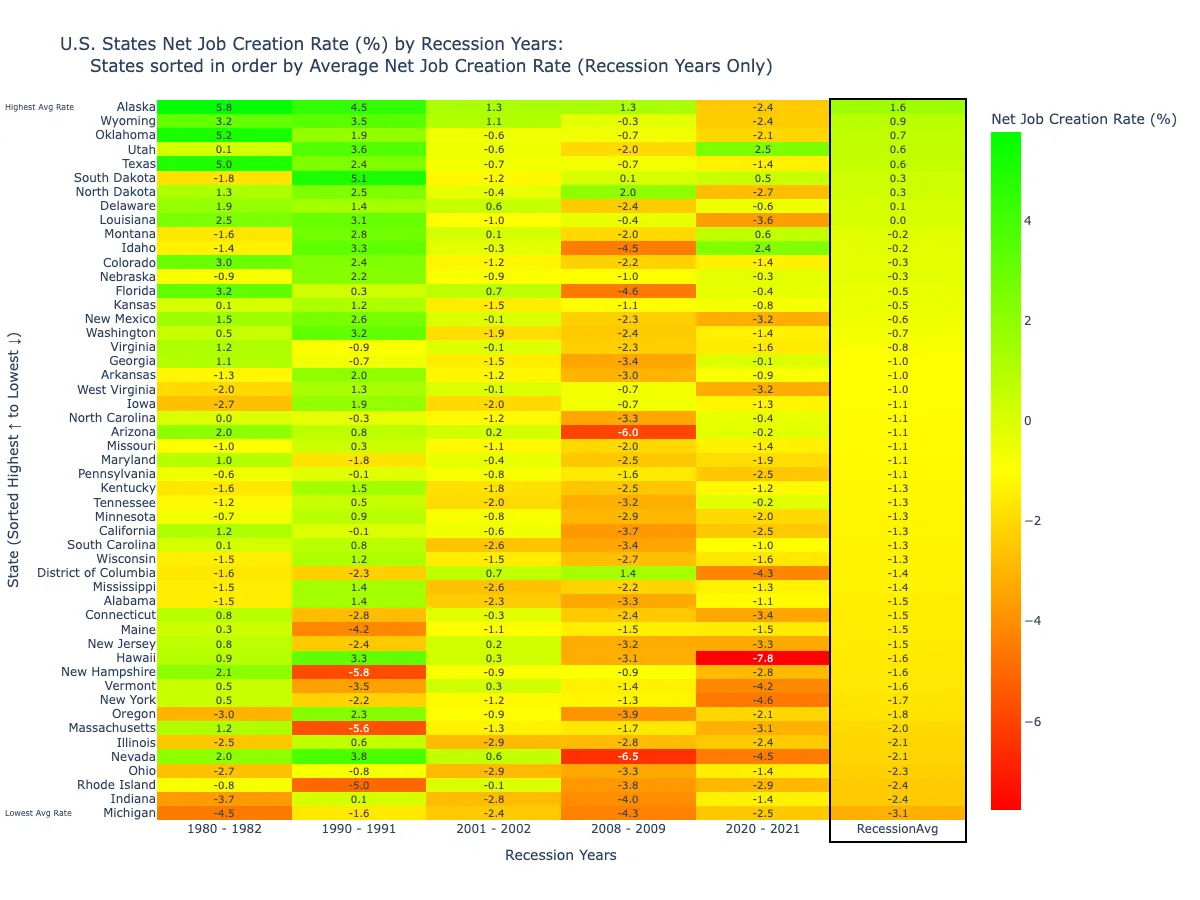How U.S. States Bounce Back in Tough Times
This post utilises the Business Dynamics Statistics (BDS) dataset from the U.S. Census Bureau API and employment statistics from the U.S. Bureau of Labor Statistics.
Table of contents
Open Table of contents
1. Introduction
These days, the global economy can be pretty unpredictable.
Are you intrigued by why some countries handle economic ups and downs better than others? Today, let’s explore what makes an economy resilient.
Understanding Economic Resilience
First off, what’s economic resilience? In a nutshell, it’s a country’s ability to withstand economic downturns and keep growing over the long haul. One way we measure this is by looking at how businesses are doing — like how many new companies are starting up, how many are closing down, and how that’s affecting jobs.
Over the past four decades, the U.S. has faced several economic hiccups:
- 1980s Recession: Double-digit inflation and strict monetary policies pushed unemployment close to 11%!
- 1990 Recession: Oil price spikes from the Gulf War and a credit crunch due to the Savings and Loan crisis caused unemployment to climb toward 8%, impacting manufacturing and real estate.
- 2001 Recession: The combination of the tech bubble burst, drop in investments, and the 9/11 attacks hit manufacturing and services hard.
- 2008 Financial Crisis: The housing market collapsed due to the subprime mortgage crisis, with GDP contracting and unemployment peaking at 10%.
- 2020 COVID-19 Pandemic: Lockdowns led to mass layoffs, especially in hospitality and retail. But quick government action, like stimulus packages, helped speed up recovery.
Let’s kick things off by looking at U.S. national trends in how jobs are being created and lost over time. We’ll then dive into the specific U.S. states to see how they’ve handled things and what’s helping or holding back their economic resilience.
2. Our Game Plan
To dig into this, we combined data from:
- U.S. Business Dynamics Statistics (1978 - 2022): Tracks job creation and destruction, as well as business openings and closings.
- U.S. Annual Employment Statistics (1978 - 2022): Provides info about the labour force, like unemployment rates.
We looked at all 50 U.S. states plus D.C., focusing on:
- Job Flows: How many jobs are being created and destroyed.
- Labor Market Metrics: Unemployment rates.
What We Wanted to Find Out
National Trends: What’s been happening with jobs across the U.S. since 1978?State-Level Resilience: Do certain states demonstrate that they’re better at handling economic shocks?Policy Impact: How do different policies affect states’ economic performance?
Let’s explore these questions in the next three sections.
3. U.S. Job Trends Over Time
Let’s start by looking at the big picture. (downturns are boxed in grey):

Key Observations
- During recessions, what usually happened:
Job Losses Spike: More jobs are lost than created, leading to net job losses (1982, 1991, 2002, 2008, 2021)Unemployment Rises: As you might expect, unemployment rates go up.Severity Varies: Some recessions are worse than others. The 2008 crisis and 2020 pandemic were particularly rough due to systemic financial meltdown and widespread lockdowns.Recovery Patterns: After these downturns, recoveries can be gradual or fast. The 2020 recovery was quicker thanks to rapid government action.
- During good times, when the economy is stable:
Steady Job Growth: More jobs are created than destroyed, leading to net job gains (e.g. 1992 - 2000 saw over 20 million net jobs created).Unemployment Falls: People find work more easily.
- Unemployment trends:
Closely Linked to Job Creation/Loss: When net job creation is up, unemployment tends to go down, and vice versa.
Bottom Line
When the economy is stable, jobs grow steadily, and unemployment rates drop. Conversely, during downturns, we see spikes in job losses and higher unemployment — the severity depends on what led to the downturn.
4. State-Level Resilience
Now, let’s zoom in on how individual states have performed.
Ranking the States
We ranked states based on their average net job creation rate from 1978 to 2022. Here’s what we found:

| Top 5 States | Bottom 5 States | |
|---|---|---|
| 1st: Utah: 2.9% | 51st: West Virginia: 0.3% | |
| 2nd: Nevada: 2.7% | 50th: Connecticut: 0.6% | |
| 3rd: Arizona: 2.7% | 49th: Ohio: 0.7% | |
| 4th: Florida: 2.4% | 48th: Illinois: 0.7% | |
| 5th: Idaho: 2.3% | 47th: Rhode Island: 0.7% |
All states had positive job creation on average, but the gap between the top and bottom is quite noticeable.
Performance During Recessions
We also looked at how states did specifically during downturns:

| Top 5 States | Bottom 5 States | |
|---|---|---|
| 1st: Alaska: 1.6% | 51st: Michigan: -3.4% | |
| 2nd: Wyoming: 0.9% | 50th: Indiana: -2.4% | |
| 3rd: Oklahoma: 0.7% | 49th: Rhode Island: -2.4% | |
| 4th: Utah: 0.6% | 48th: Ohio: -2.3% | |
| 5th: Texas: 0.6% | 47th: Nevada: -2.1% |
The top 5 states managed to keep creating more jobs than they lost, even when the economy was in the doldrums. In contrast, the bottom 5 saw significant job losses during recessions.
Bottom Line
Resilient States: States like Utah and Arizona showed strong resilience over time. Even though Nevada got hit hard during recessions periods, it bounced back impressively during recovery.Struggling States: States like West Virginia and Connecticut faced ongoing challenges, with weak growth even in better times.
5. Case Studies: Utah, Nevada, and West Virginia
Let’s take a closer look at these states to see what contributes or hinders their economic resilience.
Utah: Steady and Strong
What’s Going Right in Utah?
- Diversified Economy: Utah has a balanced mix of industries like technology, petrolum production, finance, and tourism. This means if one sector takes a hit, others can keep things afloat.
- Investment in Education: The state puts a lot into education and training, especially in science, technology, engineering, and math (STEM) fields. This prepares a skilled workforce ready for modern industries.
- Business-Friendly Environment: Utah offers incentives like tax credits and grants, and it keeps regulations streamlined to make it easier for businesses to operate.
The Result
Consistent Job Growth: Even during tough times, Utah manages to keep creating jobs.Economic Resilience: The state’s policies and diverse economy help it weather economic storms better than many others.
Nevada: Bouncing Back Quickly
Challenges in Nevada
- Tourism-Dependent: Nevada, especially places like Las Vegas, relies heavily on tourism and entertainment. During downturns, when people travel less and spend less on leisure, this can hit the state hard.
What Nevada Is Doing About It
- Diversification Efforts: The state is investing in other sectors, like electric vehicle manufacturing (think Tesla’s Gigafactory) and renewable energy projects.
- Supporting Startups and Small Businesses: Nevada offers incentives and has programs to help new businesses get off the ground.
The Result
Strong Recovery After Downturns: Even though Nevada suffers during recessions, its efforts to diversify help it bounce back more quickly.Economic Resilience Through Adaptation: By not putting all its eggs in one basket, Nevada is working to become more resilient.
West Virginia: Facing Tough Challenges
What’s Holding West Virginia Back?
- Over-reliance on Declining Industries: The state’s economy depends heavily on coal and other mineral resources. As demand for coal has declined due to environmental concerns and market shifts, this has hit the state hard.
- Workforce Issues: High unemployment rates and low labor force participation make it harder for the economy to adapt.
The Result
Struggles to Grow: West Virginia has a tough time creating new jobs, even when the national economy is doing well.Need for Transition Planning: The state’s challenges highlight the importance of planning for economic transitions, especially when key industries are declining.
Bottom Line
So, what can we learn from these states?
- Diversify the Economy
Why It Matters: Relying on one or two industries can be risky. If those sectors decline, the whole economy can suffer.Examples: Utah’s mix of industries helps cushion against downturns. Nevada is working to diversify beyond tourism.
- Support Small Businesses and Entrepreneurship
Why It Matters: Small businesses are often engines of job creation and innovation.Examples: Nevada offers incentives and simplifies regulations to help startups thrive.
- Invest in Education and Workforce Development
Why It Matters: A skilled workforce attracts businesses and helps the economy adapt to new industries.Examples: Utah’s focus on STEM education prepares workers for high-demand fields.
- Plan for Economic Transitions
Why It Matters: Industries change, and economies need to adapt.Examples: West Virginia’s struggles show the importance of planning ahead when key industries decline.
6. Conclusion
Wrapping It Up
By looking at job creation and loss, we can see clear differences in how states handle economic ups and downs.
States Like Utah: Show that industry diversification, education, and business-friendly policies contribute to resilience.States Like Nevada: Even with vulnerabilities due to their heavy reliance on a few key industries, they can improve resilience through support for new businesses and emerging industries.States Like West Virginia: Highlight the challenges of relying too heavily on declining industries and the need for proactive planning.
Acknowledging the limitations
Not the Whole Story: Job creation is important, but its just one piece of the puzzle. Other factors like income levels, specific industry trends and population movement also contribute to a state’s economic resilience.Policies are Complex: Our discussion of state policies is not exhaustive. While we touched on some key policies, there’s a lot more that goes into a state’s economic performance.Data Constraints: Our analysis goes up to 2022. Things may have changed since then.
Looking Ahead and Getting Involved
To build stronger, more resilient economies, states can consider policies to encourage diversification, boost workforce development, support entrepreneurship and plan ahead for change.
I hope that this has given you some insight into how states can build economic resilience over time. By staying informed and engaging with your community and local leaders, you can help shape policies that strengthen your state’s economy.
Feel free to share your thoughts. Let’s keep the dialogue going on how each of us can help build stronger, more resilient economies.
Further Reading: